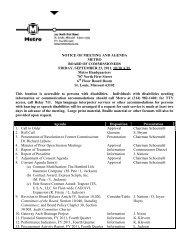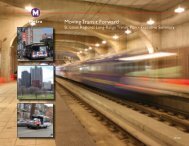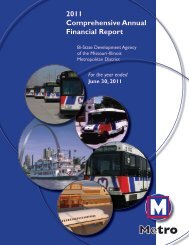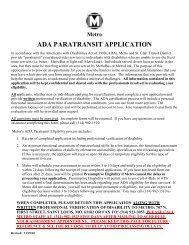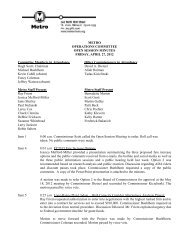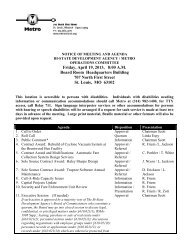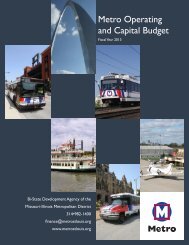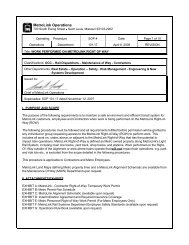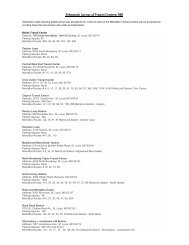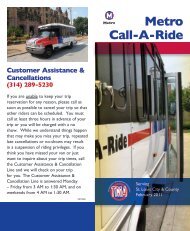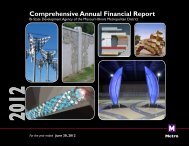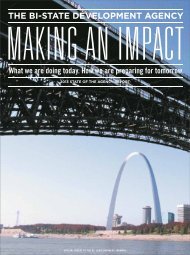st.louis regional transit -oriented development best ... - Metro Transit
st.louis regional transit -oriented development best ... - Metro Transit
st.louis regional transit -oriented development best ... - Metro Transit
You also want an ePaper? Increase the reach of your titles
YUMPU automatically turns print PDFs into web optimized ePapers that Google loves.
WHY PLAN FOR TRANSIT-ORIENTED DEVELOPMENT<br />
TOD offers the community many economic and social benefits, including neighborhood revitalization,<br />
decreased car travel and traffic conge<strong>st</strong>ion, enhanced connections between people and jobs, and the<br />
provision of affordable housing. If carefully planned and effectively implemented, TOD offers great<br />
positive impact on the life<strong>st</strong>yles of residents, riders, neighbors, and cu<strong>st</strong>omers.<br />
URBAN REVITALIZATION<br />
Central Business Di<strong>st</strong>ricts and older, inner-ring suburbs that maintained access to <strong>transit</strong> often are more<br />
attractive to businesses and workers due to a wider range of travel options, enhanced access to<br />
numerous de<strong>st</strong>inations and activities, and a full range of urban amenities. TOD improves the physical<br />
surroundings and residential quality of life by growing businesses that meet the day-to-day needs of<br />
residents, <strong>transit</strong> riders and employees; creating active, ground-level uses that attract pede<strong>st</strong>rian traffic;<br />
and providing public spaces that enhance the actual – or even perceived – level of public safety. TOD is<br />
a powerful tool for revitalizing communities that have experienced abandonment, neglect, and<br />
disinve<strong>st</strong>ment over the la<strong>st</strong> few decades.<br />
REGIONAL ECONOMIC DEVELOPMENT<br />
<strong>Transit</strong>-<strong>oriented</strong> <strong>development</strong>, if carefully planned and implemented, offers significant economic<br />
spillover throughout a region. TOD can attract new residents and generate new businesses – especially<br />
when part of a dynamic, comprehensive economic <strong>development</strong> <strong>st</strong>rategy – in turn producing jobs, tax<br />
revenue, and positive secondary economic impacts. Building a range of new housing options and<br />
businesses around <strong>transit</strong> <strong>st</strong>ations will improve connections and commute times between people and<br />
jobs. That enhanced connectivity provides a wider array of employment options for people who cannot<br />
travel to areas of new job growth in car-centered suburbs, particularly the urban poor. It may also<br />
attract ‘choice’ riders from cars to <strong>transit</strong>, reducing conge<strong>st</strong>ion on the region’s highways and saving<br />
businesses time and money on freight and truck transportation.<br />
AFFORDABLE HOUSING<br />
Moderate- and low-income families across the country are moving ever farther away from jobs in order<br />
to find housing they can afford; however, the increased co<strong>st</strong> of commuting often amounts to more than<br />
the amount saved. The Federal Partnership for Su<strong>st</strong>ainable Communities promotes greater coordination<br />
of housing and <strong>transit</strong> policy, and encourages affordable housing to be built with direct access to <strong>transit</strong>.<br />
This initiative promotes infill <strong>development</strong> and employment opportunities in the inner city and innerring<br />
suburbs. Homes may be smaller and sometimes more co<strong>st</strong>ly, but residents in these homes save<br />
money due to the decreased co<strong>st</strong>s of owning and operating an automobile. Figure 1 illu<strong>st</strong>rates how<br />
households in better-connected communities spend less on annual transportation co<strong>st</strong>s. According to a<br />
report from the Center for <strong>Transit</strong>-Oriented Development (CTOD), living in a walkable neighborhood<br />
with a good mix of uses and direct access to public transportation can provide a 16 percent savings over<br />
living in a car-<strong>oriented</strong> environment.<br />
TOD Be<strong>st</strong> Practices Guide January 14, 2011 6



